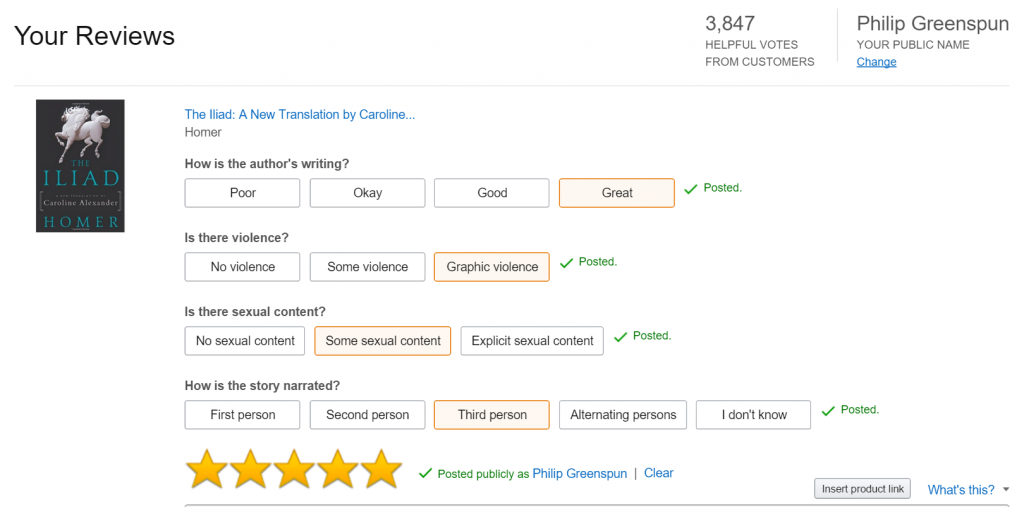Here are some excerpts from a December 14, 2015 New Yorker story about a hit TV show about a transgender senior citizen:
Sometimes, though, Soloway sounds not entirely unlike that women’s-studies professor she played. “A patriarchal society can’t really handle that there’s such a thing as a vagina,” she said. “The untrustworthy vagina that is discerning-receiving.” Soloway, who recently turned fifty, was wearing leggings and blue nail polish and a baseball cap that said “Mister.” She sped past a stretch of Craftsmen bungalows, whose front yards were studded with bicycles, jade plants, and toys. “So you can want sex, you can want to be entered, and then a minute later you can say, ‘Stop—changed my mind,’ ” she continued. “That is something that our society refuses to allow for. You don’t feel like it now? You’re shit out of luck. You know why? Because you have a pussy! To me, that is what’s underneath all this gender trouble: most of our laws are being formed by people with penises.”
The eldest sibling, Sarah, leaves her husband to pursue an affair with her college girlfriend, after they reunite at the school that their children attend.
Every decision on the show is vetted by Rhys Ernst and Zackary Drucker, trans activists and artists whose work about their relationship appeared in the most recent Whitney Biennial. “We monitor the politics of representation—if we catch things in the writing stage, it’s kind of optimal because then there’s time to shape it,” Drucker told me. “We’re kind of starting over with ‘Transparent,’ and with the trans tipping point in general.”
But, if trans people are scapegoats for the right, they are also requiring the left to undertake a momentous shift in thinking. “We’re asking the whole world to transition with us to a less binary way of being,” Drucker said. “It’s the next step in the fight for gender equality: removing the habit of always qualifying a person as a man or a woman. If we start thinking of each other as just people, it allows us to identify with each other in a way that has never really been possible before.”
“A really interesting thought exercise is to say ‘they’ and ‘them’ for all genders,” Soloway instructed me. I was confused, so she explained. “If you said, ‘I have to go pick up my friend at the airport,’ I could very easily say, ‘What time do they get here?’ So there is a structure for talking about your friend and not knowing their gender—and it’s perfect English.”
in the second season, Ali Pfefferman would go to graduate school for gender studies, and that she would have an affair with a magnetic and much older female professor.
Soloway and her husband were in an amorphous process of separating, which is ongoing. [Read the California chapter of Real World Divorce to find out how, even if there is a near-term settlement, litigation regarding alimony could continue until one of them dies.]
Will migrants from traditional cultures, and the children of those migrants, such as Soloway’s fellow Californians Syed Farook and Tashfeen Malik, agree with some of the above ideas that are valorized by this popular show?
I decided to test the question by asking adult grandchildren of Middle Eastern immigrants. They are Muslim and nobody in the family drinks alcohol, but their female family members do not wear hijabs. The children had grown up in rich liberal suburban neighborhoods and attended public schools. A native-born American casually talking to these folks would hear no accent and nothing about religion. What was the verdict on Transparent and the above ideas?
- Transgender: “I don’t have a problem with people getting surgery or wearing whatever clothes they want, but why do I have to hear about it? I never cared one way or the other before.”
- Lesbian love: “It’s okay to be gay if you are private about it. Breaking up your children’s home so that you can enjoy sex with someone other than your husband is not okay. Telling other people all the time that you are gay is not okay. Telling children that you are gay is not okay. I don’t want children exposed to a gay schoolteacher.”
- Soloway herself divorcing: “People who don’t value family should not be imposing their belief system on others via the media. If I had children I wouldn’t let them watch television.” Won’t they hear about all of the shows from their friends at school? “I would look for a private Muslim school so that they aren’t exposed to these ideas when they’re not ready for them.”
- Women as victims of a patriarchal society and gender studies as a major: “They major in gender studies and then complain that they don’t get paid as much as a doctor? Nobody in our family would be allowed to major in gender studies.”
If we assume that the above excerpts accurately reflect the cultural direction of native-born Americans, and that the above reactions accurately reflect the farthest that a immigrant’s child can go in the direction of assimilation, how can we expect immigrants from traditional cultures, or any children that they have while here, to adapt (at least within our lifetimes)? And, given that acceptance of values that are in conflict with traditional culture or religion may not be considered a virtue by some immigrants, why would we expect them to adapt?
[Separately, I decided to extend my co-authors’ survey results regarding Massachusetts family law (see about halfway down this intro chapter). These smart young people were familiar with non-working divorcées living in $1+ million houses, driving luxury cars, etc. However, they were unaware that having sex with three high-income professionals could yield the same income as studying for and joining that profession. They wrongly believed that child support revenue following a one-night sexual encounter was somehow limited and generally less lucrative than child support cashflow following a marriage. They wrongly believed that it was illegal and therefore impractical to sell an abortion for cash. Although the children of divorce with whom they were familiar had no more than every-other-weekend contact with their fathers, they wrongly believed that Massachusetts law favored a 50/50 shared parenting arrangement. They wrongly believed that Massachusetts law makes a divorce lawsuit more profitable in the event of fault, e.g., if a defendant were having an affair.]
Related:
- “Reports of Attacks on Women in Germany Heighten Tension Over Migrants” (New York Times, 1/5/2016): “The descriptions of the assailants — by the police and victims quoted in the news media — as being young foreign men who spoke neither German nor English immediately stoked the debate over how to integrate such large numbers of migrants and focused new attention on how to deal with the influx of young, mostly Muslim men from more socially conservative cultures where women do not share the same freedoms and protections as men.”
Full post, including comments 
